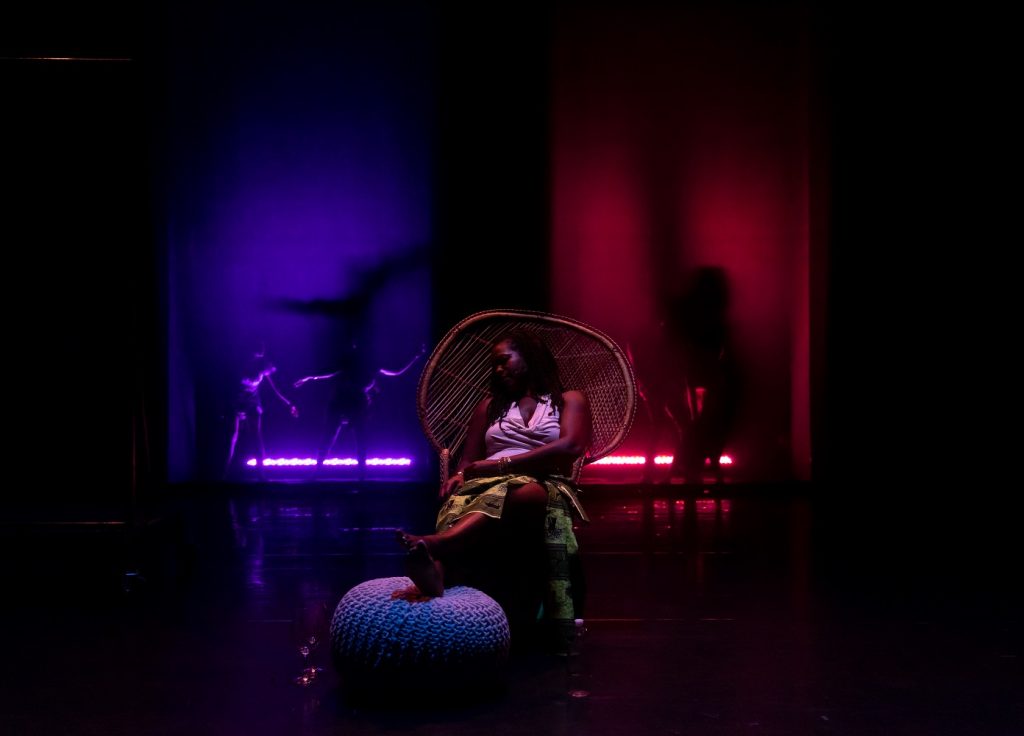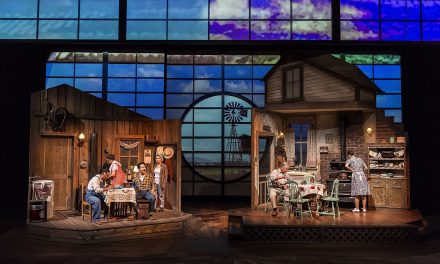NOW Festival’s third week at REDCAT gave us a daring and bold curation of heavy topics, and thoughtful prose. While the other two weeks of the festival were grounded in more movement curation, week three provided the power of speech in dense theatrics and weighted monologues. With the assistance of movement to tell a story, audience members had a refreshing change of pace from the past two weeks of NOW, leaving us with thoughtful ideas about how we may view the world and the power one conversation can have.
Walking into the theater space, the audience and performer line was blurred, as the beautiful scenic design by Emily MacDonald and lighting design by Chu-Hsuan Chang gave an inviting environment of warm and welcoming colors for Sara Lyons’ “This Emancipation Thing”. With plush pillows, rugs, low ottomans, blankets, small televisions and a set of 4 chairs facing one another, the audience was encouraged to sit on stage, take a tea cookie and relax. While we mingled, an image of “protective rules for consciousness-raising” appeared on an ivory sheet that was hung upstage. As an audience member, both my program and the actors on stage, made us aware of the following questions surrounding orgasms, sex, feminism, reproductive rights, abortion, and the first hand experiences and testimonies that would be shared. It became clear, as the five women on stage began their script, that we were welcomed into an immersive therapy experience to listen, engage, and even possibly learn something. Every so often, performer Alanna Blair would pick up a film camera and focus in on the setting of the room; the print of someone’s pant pattern on stage, the design on the teapot in the middle of their circle, or the wedding ring on a hand. I loved the hyperfixation of these small moments made large. The representation of chance by image built on subconscious memory was blown up for the theater and it was powerful. In conversation with Alanna, we heard from Ginna Diaz, Patty Gone, Jennifer Jonassen, and Chenoa Rae who gave first person testimony woven in with text adapted by Lyons from archival documents by Vivian Gornick for The New York Times Magazine, Shulamith Firestone, New York Radical Feminists, New York Radical Women, and Redstockings.
The conversation had a few comical moments which offered a nice reprieve, but really hit with heavy and truthful script as we were reminded of the feminists who came before us and how lots of things have changed… and how many things have not. There were a few important sections that felt quietly disconnected; Blair removed their shirt and remained topless for the remainder of the performance which came without any context or explanation. The script jumped from topic to topic with a black out and “whooosh” noise to represent the passing of time, but this left me with the feeling that we were covering too much and moving too quickly when I was not ready. After all, these topics are fresh and poignant in today’s society. The performers also broke specific scripted characters they carefully built as themselves on stage by giving audience members the chance to “testify” and remark on personal history of their own. In some ways, I felt this was important commentary on “the world is just a stage” and we break between our true personas, and how we portray ourselves to the world all the time. However, in this quick context it felt uncomfortably forced and again, too fast. I wanted to sit with this performance for another four hours, I wanted to dive in and learn, I wanted the space to let things go, I wanted to speak with my neighbor; especially since the immersive experience was set to involve the audience from the beginning. All in all, a truly remarkable artistic research experiment crafted for the stage. But it did leave the me with a shuffle of thoughtful, and for some painful, memories with not enough time to digest them.
As we moved into Sarahjeen François’ “Sister, Braid My Hair” performed by François, Adzua Ayana Asha Amoa, Eboni Alexander, and Dionne Robinson I was prepared for another heavy hitter. We were shown slideshow images of important black figures we’ve lost within the last few years such as Breonna Taylor and George Floyd. The images were pixelated and grainy, and these being such iconic photographs, I was excited for the possible commentary on “muddled memory” or “unfocused recollection.” But as soon as the first performer stepped out on stage in a modern take of traditional Haitian garb, and the piece began, the importance of these American figures never resurfaced leaving me perplexed and confused. Perhaps this was intended to set a tone, to reflect back and remember; however, these images set the audience up with so much pre-disposed history, that to drop it felt fragmented. The theater work used rhythmic poetry and spoken word to tell the story of preservation through the bonding of hair braiding. François paid homage to her culture, by setting each scene with loving words of affirmation, and beautiful movement to support the elegance and royal nature of a woman. The performers would often walk toe to heel, waving their arms in a slow side to side gesture slightly behind their back, with heads lifted, and eyes focused on a dream in front of them. In between scripts the women broke out in small dance, showcasing traditional Afro-Caribbean movement and motifs which further rooted François’ message to preserve the only thing her ancestors could bring with them: oral stories and dance. While it was sometimes hard to follow what time period we were in, or what specific message was being delivered, the union and connection between each of the women was magic to watch.
The last and final piece titled “Fault | Lines” was choreographed and performed by members of The Rock Collection: Arletta Anderson, Jamar Morris, Finn Murphy, Nguyễn Nguyên, Sarri Sanchez, and Erik Speth. The piece used warm halogen lights, floor bound, and connected by cord to juxtapose the colder, and more mobile, hand held LED lights to contextualize their bodies as shadows in space. As the dancers sifted between one another, Jamar Morris gave an impressive and moving spoken word performance as his voice became a dance all onto itself. With the five movers, six including Morris, the two different lights illuminating body parts and pathways, the contrast between small gestures and luxurious leaps, it was hard to focus on the context of what Morris was speaking about. On top of that we had cinematic and spatial sound by designers Eric Mason and George Malek that accompanied the dancers, and I found myself distracted on not only an auditory level but on a visible level as well. Oftentimes the LED lights would be blinding and divert my attention away from the movement; giving way to my own feelings of distraction instead. I found that I could not enjoy the process of all my senses becoming one, as the dancers linked and connected not only with one another but the mechanics of their own bodies. On the precipice of greatness, I kept hoping one element would be eliminated, so I had my own space as an audience member to breathe and take it all in.
While week three of NOW was starkly different from the previous weeks, I enjoyed the risks each of these performers took to grow their own practice and find discomfort in the art of boundary pushing. Even with disconnection, each piece offered a new feeling, a new idea, and a new way of viewing something I have seen and heard before. Even though each performance left me with fragments of ideas unfulfilled, I felt honored to be a part of the conversation, to be a part of the experiment, to be a part of original and thought provoking art. The genius is always in the bravery to be yourself, and the NOW Festival at REDCAT continues to support this message and carry it through year after year.
To learn more about Roy and Edna Disney/California Arts Theatre (REDCAT), please visit their website.
Written by Grace Courvoisier for LA Dance Chronicle.
Featured image: REDCAT NOW Festival – “Fault | Lines” by The Rock Collection – Photo by Angel Origgi









